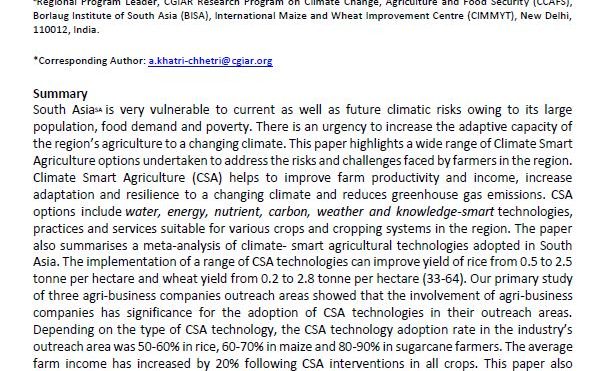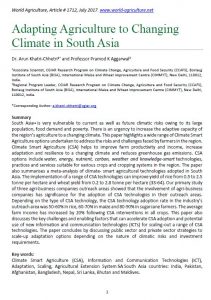South Asia is very vulnerable to current as well as future climatic risks owing to its large population and high levels of food demand and poverty. There is an urgency to increase the adaptive capacity of the region’s agriculture to a changing climate. This paper highlights a wide range of climate-smart agriculture options undertaken to address the risks and challenges faced by farmers in the region. Climate-smart agriculture (CSA) helps to improve farm productivity and income, increase adaptation and resilience to a changing climate, and reduce greenhouse gas emissions. CSA options include water-, energy-, nutrient-, carbon-, weather- and knowledge-smart technologies, practices and services suitable for various crops and cropping systems in the region. The paper also summarises a meta-analysis of climate-smart agricultural technologies adopted in South Asia. The implementation of a range of CSA technologies can improve rice yields from 0.5 to 2.5 tonnes per hectare and wheat yields from 0.2 to 2.8 tonnes per hectare (33–64). Our primary study of three agri-business companies showed that the involvement of these companies has significance for the adoption of CSA technologies in their outreach areas. Depending on the type of CSA technology, the adoption rate in the industry’s outreach area was 50–60% for rice, 60–70% for maize and 80–90% for sugarcane farmers. The average farm income has increased by 20% following CSA interventions in all crops. This paper also discusses the key challenges and enabling factors that can accelerate CSA adoption and potential use of new information and communication technologies for scaling out a range of CSA technologies. The paper concludes by discussing public sector and private sector strategies to scale up adaptation options depending on the nature of climatic risks and investment requirements.
Region: Asia
Date published:
2017
Published by:
World Agriculture
Type of resource:
Journal article
Resource topic:
Climate change, Maize, Rice, Sugarcane
Project/Programme: Not specific
Pest/Disease: Not specific
Pages:
14
File type:
External link (596 KB)




